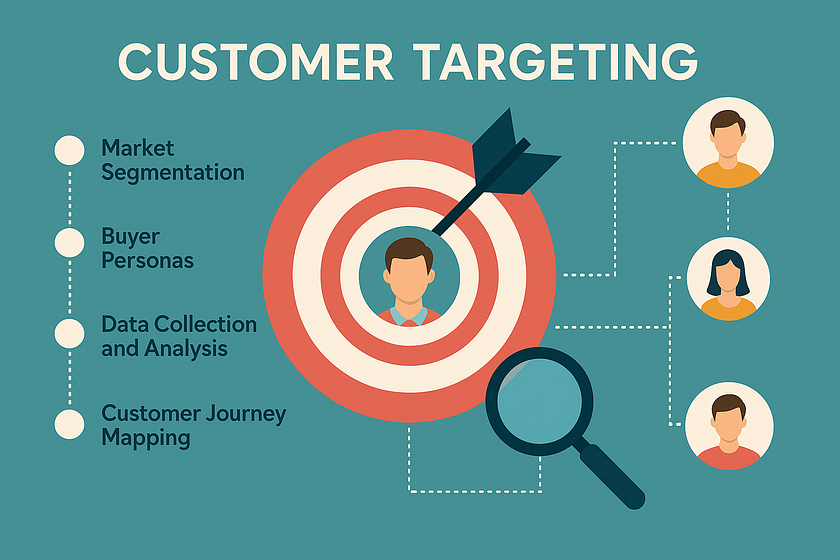Mastering Customer Targeting: The Key to Smarter Marketing and Higher Conversions

In today’s highly competitive digital landscape, businesses can no longer afford to cast a wide net and hope to catch loyal customers. Effective marketing is about precision, and that’s where customer targeting comes into play. Understanding who your customers are, what they want, and how they behave allows brands to craft personalized experiences that convert interest into revenue. This blog explores the concept of customer targeting, its importance, strategies, and how businesses can implement it to gain a competitive edge.
What is Customer Targeting?
Customer targeting is the process of identifying and reaching out to a specific group of consumers who are most likely to purchase a product or service. Instead of marketing to everyone, businesses focus their efforts on those who show signs of interest or need.
This targeted approach not only reduces marketing waste but also increases the chances of higher engagement, conversion, and retention rates. Customer targeting enables brands to deliver relevant messaging to the right people at the right time through the right channel.
Why Customer Targeting Matters
- Efficiency in Marketing Spend
By concentrating resources on the most valuable segments, companies save time and money. Rather than investing in broad campaigns, targeted efforts yield better ROI with fewer resources. - Enhanced Customer Experience
When customers feel understood, they are more likely to engage. Personalization based on accurate targeting builds stronger connections, trust, and loyalty. - Higher Conversion Rates
Targeted messages lead to more meaningful interactions, which result in increased conversions. The likelihood of turning a lead into a paying customer is significantly higher when the message resonates with their specific needs. - Stronger Brand Positioning
By focusing on a defined audience, businesses can tailor their voice and value proposition to stand out in the minds of their ideal customers.
Key Components of Effective Customer Targeting
- Market Segmentation
The foundation of targeting begins with segmenting your audience. This means dividing your overall market into smaller groups based on:
- Demographics (age, gender, income)
- Geographics (location, climate, urban/rural)
- Psychographics (lifestyle, values, interests)
- Behavioral data (purchase history, website visits, brand loyalty)
- Buyer Personas
A buyer persona is a fictional profile of your ideal customer, developed through research and data. It includes their goals, pain points, motivations, and behavior. Creating personas helps marketing teams understand and address specific customer needs. - Data Collection and Analysis
Modern targeting is powered by data. Brands collect information from CRM systems, social media analytics, website behavior, and customer surveys to gain insights into customer preferences and patterns. - Customer Journey Mapping
Understanding the customer’s path — from awareness to consideration to decision — helps identify touchpoints where targeted communication can have the most impact.
Popular Customer Targeting Strategies
- Email Segmentation
Rather than sending the same email to your entire list, segment your audience based on purchase history or engagement level. Personalized emails have much higher open and click-through rates. - Retargeting Campaigns
If a user visits your website but doesn’t make a purchase, retargeting ads on social media or search engines can bring them back with a compelling offer. - Geo-Targeting
Target users based on their physical location. This is useful for local businesses or time-sensitive promotions. - Lookalike Audiences
Platforms like Facebook allow you to create lookalike audiences based on your existing customers. This expands your reach to people who are likely to be interested in your offerings. - AI and Predictive Targeting
Artificial intelligence can analyze large datasets to predict future customer behavior and recommend who to target next with what message.
Challenges in Customer Targeting
Despite its advantages, customer targeting comes with its challenges. Poor data quality, privacy concerns, and over-segmentation can hinder performance. It’s essential to:
- Keep customer data secure and compliant with regulations like GDPR.
- Avoid being too intrusive or “creepy” with personalization.
- Continuously test and refine segments to ensure relevance.
Measuring Targeting Effectiveness
Key performance indicators (KPIs) to track the success of your targeting efforts include:
- Conversion rates
- Customer acquisition cost (CAC)
- Customer lifetime value (CLV)
- Engagement metrics (CTR, time on site, bounce rate)
Using A/B testing and analytics tools helps marketers determine which segments respond best to which campaigns and optimize accordingly.
Conclusion
Customer targeting isn’t just a marketing tactic — it’s a business strategy. By narrowing your focus to reach only those who matter most, you increase the efficiency, impact, and ROI of every campaign. As competition intensifies and consumer expectations rise, mastering customer targeting is no longer optional — it’s essential.
Start by truly knowing your audience. Segment wisely, personalize meaningfully, and always keep refining your strategy. When done right, customer targeting will not only boost your conversions but also build lasting customer relationships that fuel long-term growth.


Comments
Post a Comment